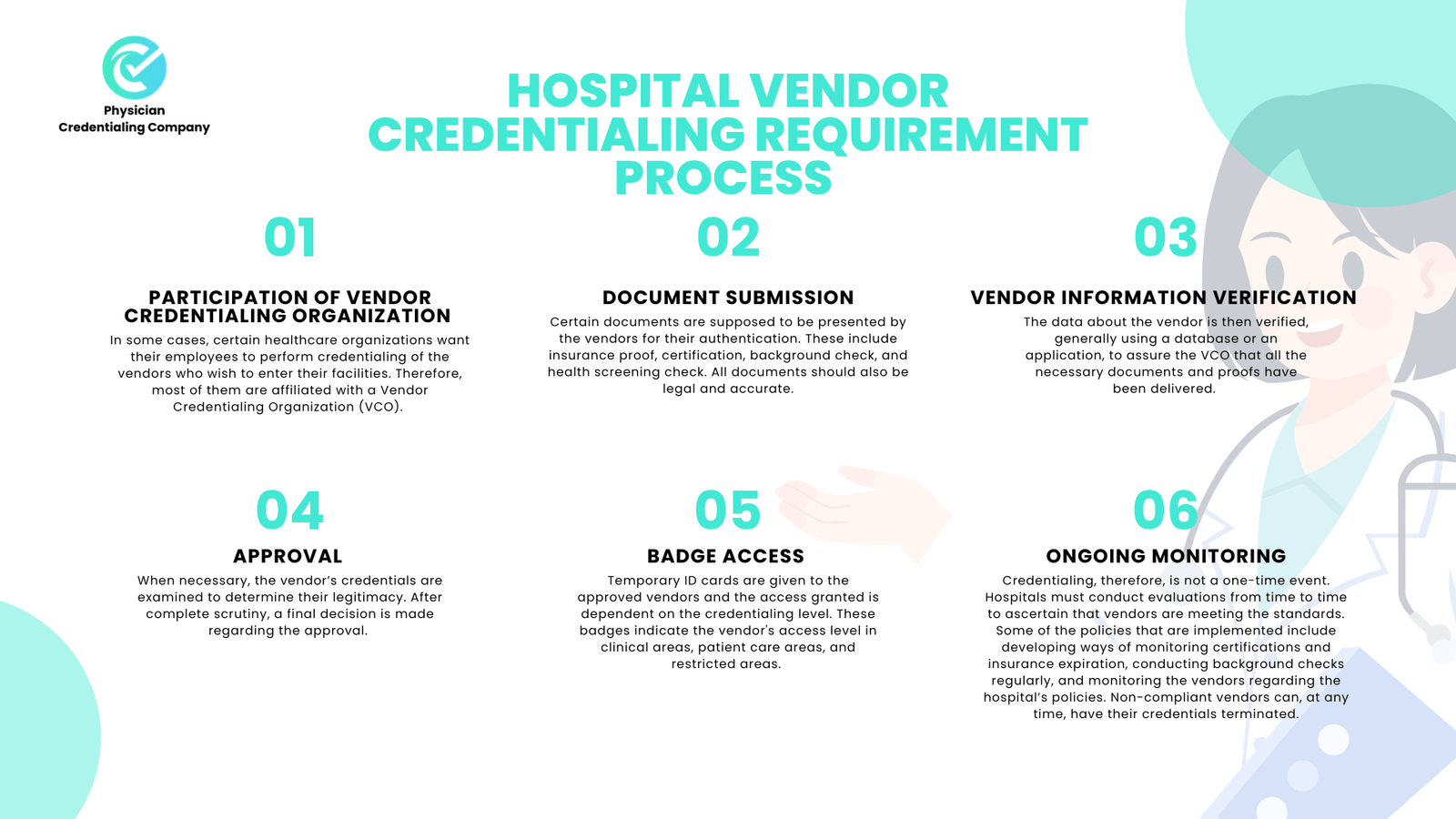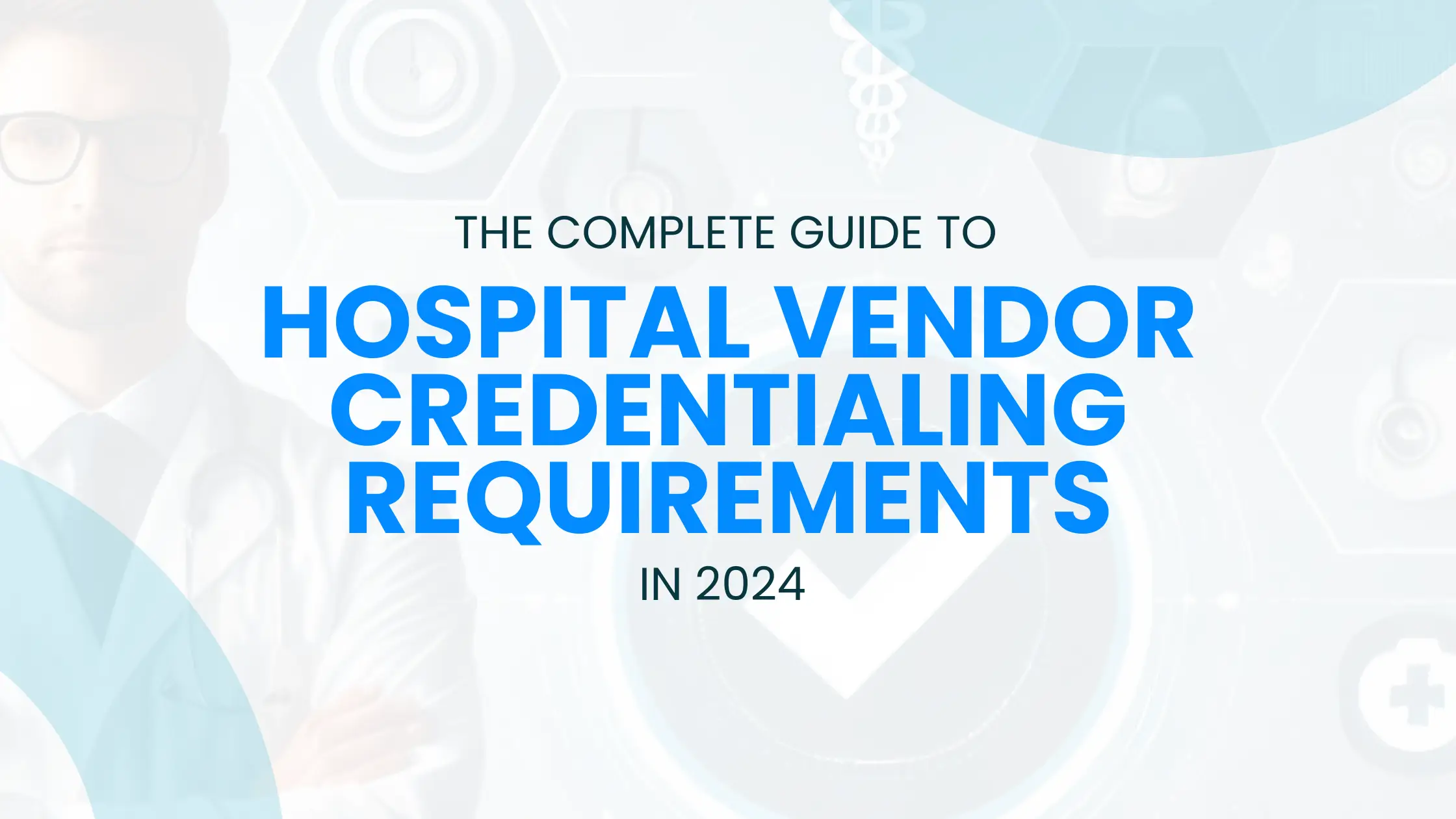It is essential to screen third-party entities that offer services to healthcare practices to protect patients’ lives. Understanding Hospital Vendor Credentialing requirements is crucial to carefully evaluate and review all services, ensuring favorable results for healthcare services that directly or indirectly interact with patients. In the mid-2000s, pseudo-patients and other unauthorized individuals could easily enter hospital premises, treat patients, and even handle patient records, highlighting the need for stringent credentialing practices.
The new development of vendor credentialing has greatly enhanced these measures. Due to regulatory rules and acts related to Hospital Vendor Credentialing requirements by state and federal agencies involving patients’ information privacy, vendor credentialing has gained importance in patient security and overall hospital safety.
In this blog, we will learn the basic aspects of healthcare vendor credentialing requirements and why it is so important to increase the effectiveness of healthcare facilities.
What is Vendor Credentialing?
Vendor credentialing is a continuous procedure healthcare institutions apply to confirm that healthcare vendors and the individuals accompanying them have completed all requisite training, certification, and immunization necessary to enter the hospital building. Every vendor must fulfill the facility’s demands to be allowed to offer the needed product or service.
Vendor credentialing is very important to protect patient safety and overall welfare. When vendor personnel report to the hospital, they are given a tag to indicate their certification status and the areas they can access.
Essential Hospital Vendor Credentialing Requirements
While different vendor credentialing systems may have unique requirements, some essential ones include:
- Employment Verification: Verifying the working status of the vendor in his/her organization.
- Certifications and Training: The qualification and training standards of vendors about the services they offer to the organization.
- Drug screening results: Ensuring that the vendors meet the necessary drug test.
- HIPAA Compliance Certification: A vendor may not be aware of the HIPAA rules and policies; thus, it is important to train vendors on the regulations and provide certificates.
- Background Checks: Any criminal record, dishonesty issues, and malpractice claims.
- Current PPD (Tuberculosis) Test Results: Control of tuberculosis among the vendors.
The Hospital Vendor Credentialing Process
We have created an infographic flow chart for vendor credentialing process and we have another good and catchy flowchart for credentialing process. Now the vendor credentialing process typically involves several key steps:

1. Participation of Vendor Credentialing Organization (VCO)
In some cases, certain healthcare organizations want their employees to perform credentialing of the vendors who wish to enter their facilities. Therefore, most of them are affiliated with a Vendor Credentialing Organization (VCO).
2. Document Submission
Certain documents are supposed to be presented by the vendors for their authentication. These include insurance proof, certification, background check, and health screening check. All documents should also be legal and accurate.
3. Vendor Information Verification
The data about the vendor is then verified, generally using a database or an application, to assure the VCO that all the necessary documents and proofs have been delivered.
4. Approval
When necessary, the vendor’s credentials are examined to determine their legitimacy. After complete scrutiny, a final decision is made regarding the approval.
5. Badge Access
Temporary ID cards are given to the approved vendors and the access granted is dependent on the credentialing level. These badges indicate the vendor’s access level in clinical areas, patient care areas, and restricted areas.
6. Ongoing Monitoring
Credentialing, therefore, is not a one-time event. Hospitals must conduct evaluations from time to time to ascertain that vendors are meeting the standards. Some of the policies that are implemented include developing ways of monitoring certifications and insurance expiration, conducting background checks regularly, and monitoring the vendors regarding the hospital’s policies. Non-compliant vendors can, at any time, have their credentials terminated.
Importance of Hospital Vendor Credentialing
1. Ensuring Patient Safety
Credentialing assists in guaranteeing that the vendors are safe to be in the patient care areas as well as qualified to work with patients. This minimizes the likelihood of patient endangerment by unprofessional or unlawful supply contractors.
2. Regulatory Compliance
Hospitals must require vendors to comply with regulatory policies from authorities including the Joint Commission, OSHA, and HIPAA. Vendor credentialing assists hospitals and vendors in adhering to these legalities and thus avoid legal cases and possible penalties.
3. Protecting Hospital Staff
The safety of patients as well as doctors is very important and it should not be neglected. Vendors generally have salesmen who are sort of irresponsible regarding maintaining the safety protocols. Therefore, policies are made for Hospital Vendor Credentialing requirements regulatory committees to maintain safety. If any hospital does not comply with these rules then, hospital staff will be held responsible for it. They can be charged with penalties and fines. Vendor credentialing is recommended to protect hospital staff physically as well as morally.
4. Maintaining High Standards of Care
Vendor credentialing ensures the adequacy of suppliers’ credentials and guarantees high-quality healthcare solutions. This shows that medical equipment is of high quality and well-sanitized to be used in the patients’ care protocols.
Best Practices for Hospital Vendor Credentialing
1. Implementing A Centralized System
A centralized system simplifies the process, and all offices can be run efficiently by making changes to one centralized system. Any information about the vendors and all documents must be kept in an accessible and most importantly, secure database. It also makes it possible to manage vendor credentials since their details can easily be inputted and checked.
2. Regular Audits & Reviews
The credentialing process should be audited and reviewed periodically to note any necessary changes. Hospitals should periodically check the vendors’ working status regarding compliance and update their policies when necessary.
3. Providing Clear Guidelines
If these services are to be outsourced, then clear guidelines and company expectations should be presented to the vendors. It is necessary to describe the general requirements, documents, and legal compliance needed to obtain a specific privilege in the hospital. Hospitals require special attention due to the diverse services that they offer and providing detailed information puts the vendors in a better position to meet the hospital’s needs.
4. Training & Education
Education and training should remain continuous, focusing on both hospital employees and vendors. Hospitals should hold meetings more frequently on topics related to compliance and safety to keep track of changing regulations. This assists in making sure that everyone knows the requirements and standards to be met.
5. Leveraging Technology
Modern technology can easily improve hospital credentialing at the state and federal levels. The proper use of the software and online training tools including AI, blockchain, and automated document entry tools can be helpful for document management, automated reminder alarms, and application tracking. This helps to ease the burden of the administration working on vendor credentialing.
Why is Credentialing Important for Vendors?
Despite the emphasis on the importance of vendor credentialing for healthcare organizations and patients’ care, it is high time to identify that credentialing also produces benefits for vendors. Appropriate credentialing requirements guide vendors and inform them of the areas and levels that must be met before they can join healthcare organizations.
Hospital credentialing by the state benefits vendors in human resource management as a way of enhancing efficiency; especially when it comes to recruiting new representatives. For instance, when a vendor starts dealing with a hospital that demands very high standards concerning the handling of bloodborne pathogen training, the vendor needs to comply with those standards to collaborate with that hospital. Particular training courses and certifications are launched which enables the vendors to do the recruitment most effectively so that they consider only the employees who possess all the requirements from the start.
Vendor credentialing is a process that has gone through changes within the past few years. If we talk about compliance controls, they are likely to rise due to COVID-19, which highlights the need to check that vendors and their representatives are trained and qualified to avoid imposing risks on healthcare workers and patients. Hospital vendor credentialing has evolved from being a mere activity that was performed to comply with Hospital Vendor Credentialing requirements and policies to be a necessary process for patients’ care and institutes’ reputation.
Conclusion
Hospital vendor credentialing is one of the most important processes that are carried out to minimize the risk of harmful events occurring to patients. Thus, in addition to ensuring the credentialing of the participating vendors, a well-developed credentialing system should be developed by the hospital to recruit professional and quality vendors.
Implementing best practices, including technological tools, centralized systems, regular audits, training programs, and clear guidelines, can enhance the efficiency of the credentialing process. To register with hospitals, vendors should have an explicit knowledge of the steps, including VCO membership, application submission, and document verification.
After these steps, a final decision is made, and a badge is presented to the vendors if approved. Using that badge, they can access the hospital’s locations to perform their tasks. Vendors should be careful about the regulatory terms and conditions to enjoy the benefits.
Furthermore, we have also covered some very insightful blogs for different but important topic like: privileging and credentialing difference, healthcare credentialing, complete understanding of credentialing process, RCM Steps, all about CAQH, so feel free to read them.

